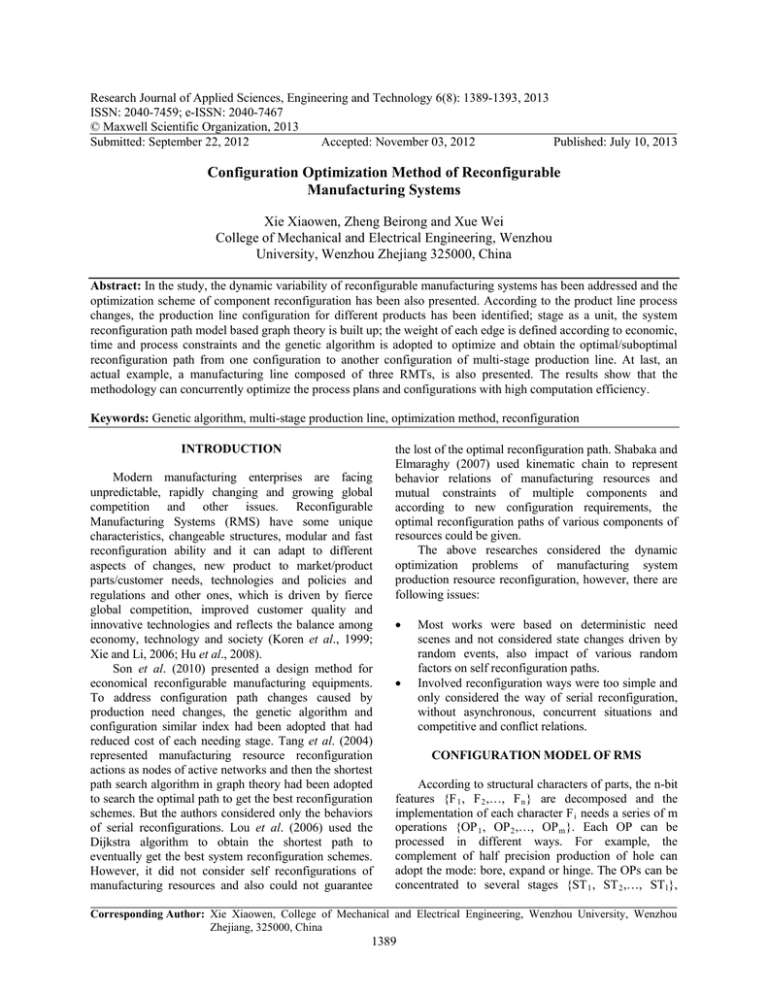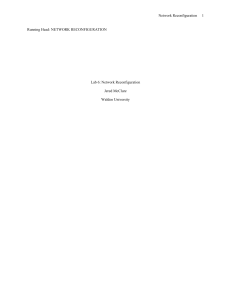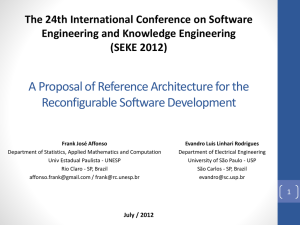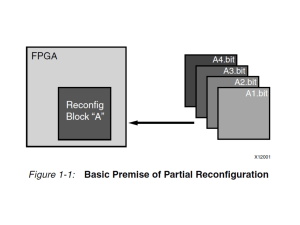Research Journal of Applied Sciences, Engineering and Technology 6(8): 1389-1393,... ISSN: 2040-7459; e-ISSN: 2040-7467
advertisement

Research Journal of Applied Sciences, Engineering and Technology 6(8): 1389-1393, 2013
ISSN: 2040-7459; e-ISSN: 2040-7467
© Maxwell Scientific Organization, 2013
Submitted: September 22, 2012
Accepted: November 03, 2012
Published: July 10, 2013
Configuration Optimization Method of Reconfigurable
Manufacturing Systems
Xie Xiaowen, Zheng Beirong and Xue Wei
College of Mechanical and Electrical Engineering, Wenzhou
University, Wenzhou Zhejiang 325000, China
Abstract: In the study, the dynamic variability of reconfigurable manufacturing systems has been addressed and the
optimization scheme of component reconfiguration has been also presented. According to the product line process
changes, the production line configuration for different products has been identified; stage as a unit, the system
reconfiguration path model based graph theory is built up; the weight of each edge is defined according to economic,
time and process constraints and the genetic algorithm is adopted to optimize and obtain the optimal/suboptimal
reconfiguration path from one configuration to another configuration of multi-stage production line. At last, an
actual example, a manufacturing line composed of three RMTs, is also presented. The results show that the
methodology can concurrently optimize the process plans and configurations with high computation efficiency.
Keywords: Genetic algorithm, multi-stage production line, optimization method, reconfiguration
INTRODUCTION
Modern manufacturing enterprises are facing
unpredictable, rapidly changing and growing global
competition and other issues. Reconfigurable
Manufacturing Systems (RMS) have some unique
characteristics, changeable structures, modular and fast
reconfiguration ability and it can adapt to different
aspects of changes, new product to market/product
parts/customer needs, technologies and policies and
regulations and other ones, which is driven by fierce
global competition, improved customer quality and
innovative technologies and reflects the balance among
economy, technology and society (Koren et al., 1999;
Xie and Li, 2006; Hu et al., 2008).
Son et al. (2010) presented a design method for
economical reconfigurable manufacturing equipments.
To address configuration path changes caused by
production need changes, the genetic algorithm and
configuration similar index had been adopted that had
reduced cost of each needing stage. Tang et al. (2004)
represented manufacturing resource reconfiguration
actions as nodes of active networks and then the shortest
path search algorithm in graph theory had been adopted
to search the optimal path to get the best reconfiguration
schemes. But the authors considered only the behaviors
of serial reconfigurations. Lou et al. (2006) used the
Dijkstra algorithm to obtain the shortest path to
eventually get the best system reconfiguration schemes.
However, it did not consider self reconfigurations of
manufacturing resources and also could not guarantee
the lost of the optimal reconfiguration path. Shabaka and
Elmaraghy (2007) used kinematic chain to represent
behavior relations of manufacturing resources and
mutual constraints of multiple components and
according to new configuration requirements, the
optimal reconfiguration paths of various components of
resources could be given.
The above researches considered the dynamic
optimization problems of manufacturing system
production resource reconfiguration, however, there are
following issues:
•
•
Most works were based on deterministic need
scenes and not considered state changes driven by
random events, also impact of various random
factors on self reconfiguration paths.
Involved reconfiguration ways were too simple and
only considered the way of serial reconfiguration,
without asynchronous, concurrent situations and
competitive and conflict relations.
CONFIGURATION MODEL OF RMS
According to structural characters of parts, the n-bit
features {F 1 , F 2 ,…, F n } are decomposed and the
implementation of each character F i needs a series of m
operations {OP 1 , OP 2 ,…, OP m }. Each OP can be
processed in different ways. For example, the
complement of half precision production of hole can
adopt the mode: bore, expand or hinge. The OPs can be
concentrated to several stages {ST 1 , ST 2 ,…, ST l },
Corresponding Author: Xie Xiaowen, College of Mechanical and Electrical Engineering, Wenzhou University, Wenzhou
Zhejiang, 325000, China
1389
Res. J. Appl. Sci. Eng. Technol., 6(8): 1389-1393, 2013
which named multi-stage production line. Each stage
correspond the specific configuration of machine tools.
The changes of production parts result in the
corresponding adjustment of production line
configurations. Adjustment from the original
configuration to the new one is named as a
reconfiguration process R. R is the composition of a
series of reconfiguration actions which can reconfigure
the production line from an original configuration to
another one? The changing process not only includes
reconfiguration actions in the system level, but also
those in the device level. Moreover those activities can
be serial or concurrent.
configuration is in turn mapped to the
corresponding
stage
of
the
destination
configuration. The mapping process is through a
series
of
reconfiguration
actions.
The
reconfiguration actions are limited by the inputoutput relation between stages. Meanwhile,
different reconfiguration actions may bring the
changes of cost and production:
O = {o1 , o2 ,, on }
where, each reconfiguration action O i can be
defined as follows:
oi = (numi , stri , upd i , ci , ti )
Description of reconfiguration path optimization:
Reconfiguration path optimization is to design the
optimal series of reconfiguration actions according to
the initial and destination configurations, given
optimization objective.
where,
The change of the number of each
mum i =
stage
Str i = The inner change of each stage such as
from serial to concurrent
upd i = The configuration change of each stage
inner devices, such as changes of inner
components, update of control software
= The cost of the reconfiguration action
ci
= The time change of the reconfiguration
ti
action
Definition 1: Reconfiguration path optimization
problem is represented as a Four-tuple RP = (G, S, R,
ST i ), G is the optimization objective, S is the
configuration, R is a series of reconfiguration actions,
ST i is various stage in the production line:
•
•
G-optimization objective: The optimization
process has multiple optimization objective, G =
{(g 1 , g 2 ,…, g n ), w}, g n represents a component of
the target vector, w is the weight of each vector.
S-production line configuration: The production
line configuration:
S = (r (STiI , STjo ), ST 1 , ST 2 ,…, ST n , n)
where,
r (STiI , STjo ) = The input-output relation between
each stage
r (STiI , STjo ) = 1, the input buffer of ith stage and
output buffer of jth stage are
connected, otherwise not connected
n
= The number of all stages of
production line
= The initial configuration
Si
= The destination configuration
Sd
•
R-a series of reconfiguration actions: Through a
series of reconfiguration actions, the production line
changes from the original configuration to the
destination one. Reconfiguration actions are a series
of actions to machining equipment and production
materials. The production line is composed of
various stages. The reconfiguration of production
line consists of the reconfiguration of each stage
that is the objective configuration is decomposed
into multiple stages. Each stage of the initial
•
ST i -the stage of production line: A production
line is divided into various stages according to
achieved processes, for example ST i ∈ ST, i = 1, 2,
.., m.
The configuration change of multi-stage production
line in some production cycle is called as a
reconfiguration cycle. The reconfiguration action will
lead to reconfiguration cost, reconfiguration time and
the reconfiguration action processes. To implement the
objective, firstly the relation between each
reconfiguration action, reconfiguration cost and time are
defined, secondly according to stages of production line,
the feasible configuration graph is obtained and the
weight sum of cost and time is computed, thirdly the
definition the weight of each edge is added according to
the weight of each edge search the optimal path between
two nodes. Furthermore, the solution process is divided
into two parts, one is the modeling part based on graph
theory and another is the solution by GA, which is
shown in Fig. 1.
Formal modeling of manufacturing system path
optimization based on the graph theory: Path
optimization model of production line during one
configuration cycle can be viewed as the shortest path
problem, shown in Fig. 2. The production line is
divided into various stages, the reconfiguration cost,
time
and
other
elements of each stage
1390
Res. J. Appl. Sci. Eng. Technol., 6(8): 1389-1393, 2013
Modelling
Production line Data
Define the OP and S based on
the part
Define the R and other
parameters
Identify the performance metrics
and goal G
New Task
Initial
configurationSi
Formally represent the
reconfigurable path of
production line based on the
graph theory
Destination
configuration
Sd
Path
solving
Genetic Algorithm
Identify the optimization
configuration path and operation
Fig. 1: The path optimization strategy of production line reconfiguration
V1, 2 ,, n
V1', 2 ,, n
V1' , 2 ' ,, n
.
.
.
V1, 2' ,,n
V1, 2 ' ,, n '
.
.
.
...
...
V1, 2 ,, n '
V1' , 2 ,, n '
.
.
.
V1' , 2' ,, n '
Fig. 2: The reconfigurable path of production line
correspond to the edges between nodes in graph. After
various reconfiguration operations, the system
reconfigure from the initial configuration to the
destination one. For the division of stages is based on
the production process of parts, the production line after
reconfiguration can guarantee the new production
requirements.
Its description is as follows: given a weight directed
graph N D = (V, A, W), V are the vertices, A is the finite
edge between nodes, W and is the weight of directed
edge.
Assume P is a path from the initial vertex V s to the
final vertex V t , which caused by R. The weight of path
P is the sum of weight of all edges, that is w (P) =
∑i,j∈P wij . The shortest path problem is to solve one path
with minimal weight from all paths of the initial vertex
V s to the final vertex V t , that is P min = min ∑i,j∈P wij .,
which is related to G.
During one configuration cycle, the configuration
of production line is as the vertex of directed graph.
According to the changes of stages by process changes
of parts, the reconfiguration actions of each stage can be
mapped to the edges of directed graph. The
reconfiguration cost, time are calculated to construct the
directed graph of production line configuration changes.
Therefore, the solution of production line configuration
optimal path can be transferred into the shortest path of
directed graph.
Genetic algorithm for path solving: In the shortest
path problem, GA can quickly get the shortest/suboptimal path without too many constraints and
restrictions.
The adjacent matrix represents whether or not
vertex V i , V j has shared edges.
Definition 2: Adjacent matrix: For an adjacent matrix
of graph with V vertex and e edges, A = [α ij ] is an v×v
order matrix, where, α ij = 1 represents V i , V j are
adjacent, α ij = 0 is they are not adjacent or i = j.
1391
Res. J. Appl. Sci. Eng. Technol., 6(8): 1389-1393, 2013
•
•
Chromosome: For a given graph model, the graph
vertex are naturally ordered and then according to
this order each candidate vertex is selected as a
chromosomal gene. When the gene value is 1
indicates that the corresponding vertex has been
selected into this path, otherwise means not. The
gene sequence of this chromosome is the
appearance sequence of vertices in this path and the
length of the chromosome is the number of vertices
in the graph.
Fitness function: For a graph with n vertexes, the
length of each edge between vertex V i , V j is known
as P (V i , V j ) and the length of a path v i1 , v i2 ,…, v in
from v i1 to v i1 is defined as the fitness function:
f (i ) =
n −1
∑ p(v
ir
Table 1: The coefficients of cost
Coefficients
α1
α2
α3
g ra
g rd
g rc
Table 2: The coefficients of time
Machine tool type M t
Coefficients value t (j)
Dedicated machine tool
1/5
Machine centers
1
Inspection equipment
1/3
, vir +1 )
•
•
G (n ) = g 1 (n ) + g 2 (n )
where,
g 1 (n) = Reconfigurable cost
g 2 (n) = Reconfigurable time
g1 (n ) = α1
∑g
ra
+ α2
∑g
V2
V7
V1 2
V3
V8
V13
V4
V9
V14
V5
V10
V15
V1
Selection operations: Individuals are selected with
a probability proportional to their relative fitness.
Namely, the survival probability of short path
individual is higher than long path. This ensures
that the expected number of offspring of a parent is
approximately proportional to its relative
performance in the population.
Crossover and mutation operations: The
crossover operation is adopted in the selected parent
chromosomes and using random generation of
random numbers to determine the crossover point,
then, in this position on the single-point crossover.
Mutation is a chromosomal inversion in a certain
gene, that is, from 1 to a 0, or vice versa. The map
reflected, for a path to remove or add last vertex.
Optimization objectives: The best/shortest path is
to find the smallest weights of selected edges. The
definition of the optimization objectives is:
rd
+ α3
∑g
rc
where,
g 1 (n) = The reconfigurable operation cost from vertex
V i to V i+1
= The increasing cost of added equipment during
g ra
reconfigurable operation
= The decreasing cost of deleted equipment
g rd
during reconfigurable operation
= The moving cost of moved equipment during
g rc
reconfigurable operation
Operation type
Add
Remove
Adjust
ti
1.2
0.8
1.5
V6
r =1
•
Value
1/3
1/3
1/3
2000
1000
2500
V16
V11
Fig. 3: The directed graph of production line configuration
adjustment
1
g 2 (n ) == ∑ ∑ t ( j ) × M t
i=n j=m
where,
g 2 (n) = The sum of all reconfigurable operation time of
a given path from vertex V 1 to V n
= t Types equipment in the production line
Mt
t (i) = The reconfigurable time coefficients of the
different machine tools
CASE STUDY
There are 2 types’ cylinder parts in production line.
The process plan of Part A is milling the surfaces
(OP10) →rough process of holes (OP20) →finished
process of holes (OP30) →Inspection and leakage
(OP40) →fine boring (OP50). The process plan of Part
B is milling the surfaces (OP10) →rough, semi-fine
process of holes (OP20) →Fine process of slant-holes
and holes (OP30) →Inspection and leakage (OP40)
→Fine hinge (OP50).
When the product changed from type A to type B,
the production line need to be reconfigurable operated.
This production line includes five stages and each stage
adjusts according to new configuration, such as
add/remove machine tools. The reconfigurable paths of
production line are showed in Fig. 3.
The Table 1 and 2 are provided by Company. The
weight of each edge can be calculated according to the
equations of Section “Configuration model of RMS”.
1392
Res. J. Appl. Sci. Eng. Technol., 6(8): 1389-1393, 2013
6
•
× 105
F Fitness
5
4
3
The optimization goals and every GA operations
are determined. Moreover, a case is presented to
show the feasibility and effectiveness of the
methodology which proposed in this study.
2
ACKNOWLEDGMENT
1
0
This study was supported in part by International
Science and Technology Cooperation Program of China
(Grant No. 2012DFG72210), Zhejiang Provincial
Natural Science Foundation of China (Grant No.
Y1111147), Key scientific and technological project of
Zhejiang Province (Grant No. 2011C14025) and Key
scientific and technological project of Wenzhou (Grant
No. H20100092).
1 5 9 13 17 21 25 29 33 37 41 45 49 53 57 61 65 69 73 77 81 85 89 93 97
G Generation
Fig. 4: Optimization curve
Initial Configuration S i
ST1
ST2
MT1
MT2
ST3
S T4
ST5
MT3
Part 1
MT5
MT6
MT4
REFERENCES
R1
Destination S
d
Configuration
ST1
R2
ST2
ST3
S T4
ST5
R4
MT6
MT2
Part 2
MT4
MT8
MT3
MT1
R3
MT5 '
Fig. 5: Reconfiguring the multi-stage production line in the
example
The GA, presented in subsection “Genetic
algorithm for path solving” is used to solve the directed
graph showed in Fig. 2. Then, the optimization curve of
best path is showed as Fig. 4.
The best individual of path is V 1 ⟹ V 3⟹ V 7 ⟹
V 12 ⟹ V 16 .
Figure 5 shows how the multi-stage production line
is reconfigured according to the best individual
reconfigurable actions. The machine MT4 is moved
from stage 3. MT5 is adjusted and moved to stage 4
from stage 5. In addition, the extra MT8 is added to
stage 5. All actions are finished step by step.
CONCLUSION
•
The characteristics of reconfigurable manufacturing
system are analyzed and the reconfiguration
processes is modeled formally using graph theory.
Hu, S., X. Zhu and H. Wang, 2008. Product variety and
manufacturing complexity in assembly systems and
supply chains. CIRP Ann. Manuf. Techn., 57:
45-48.
Koren, Y., U. Heisel, F. Jovane, T Moriwaki, G. Ulsoy
et al., 1999. Reconfigurable manufacturing
systems. Ann. CIRP, 48(2): 1-14.
Lou, H., J. Yang, Y. Lin, J. Hu, Z. Wu et al., 2006.
Reconfigurable
policy
of
reconfigurable
manufacturing systems based on graph theory.
Chinese J. Mech. Eng., 42(3): 22-29.
Shabaka, A.I. and H.A. Elmaraghy, 2007. Generation of
machine configurations based on product features.
Int. J. Comput. Integ. Manuf., 20(4): 355-369.
Son, H., H. Choy and H. Park, 2010. Design and
dynamic analysis of an arch-type desktop
reconfigurable machine. Int. J. Mach. Tools
Manuf., 50(6): 575-584.
Tang, L., D.M. Yip-Hoi, W. Wang et al., 2004.
Concurrent line-balancing, equipment selection and
throughput analysis for multi-part optimal line
design. Int. J. Manu. Sci. Prod., 6: 71-81.
Xie, N. and A. Li, 2006. Reconfigurable production line
modeling and scheduling using Petri nets and
genetic algorithm. Chinese J. Mech. Eng., 19(3):
362-367.
1393





